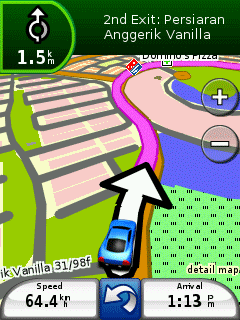How Garmin GPS Watch Models Differ
The Garmin Forerunner GPS watches are without doubt, the most advanced GPS sports watches on the market today.
By linking to a network of satellites, the Forerunner watches can accurately measure speed, pace, distance and elevation above sea level. Garmin's unique approach intertwines the power of GPS, with advanced and practical sports watch features that let you measure and recording sports performances in an intelligent and intuitive way.
But what are the similarities between the six Forerunner watches on the market? and more importantly, what are the differences?
Two Generations of Forerunners
For the purposes of this discussion, we consider two "generations" of Forerunner watches. The "older generation" includes model numbers: 101, 201 and 301, which have now been superseded by the 205, 305 and 405 models - the "current generation".
How Forerunner Watches are Similar
All Garmin Forerunner watches are all-in-one GPS wrist units, meaning the GPS aerial is mounted in the watch.
This is quite distinct from other GPS watch manufacturers such as Timex, Suunto and Polar, who require you to secure an external GPS device to your body. With Forerunner watches, you can just put the watch on your wrist and you're ready to go.
The Garmin watches also share some amazing proprietary sports watch features. Some are only found in certain models, but most are present in all Forerunner watches. Below is a summary these shared features:
Virtual Partner Feature
The Virtual Partner feature lets you train against a digital person, displaying if your virtual "competitor" is "ahead" or "behind" you.
Auto Pause/Auto Resume
Pauses and resumes the stopwatch time based on your speed. If you need to stop running at a traffic light for instance, the watch stops the stopwatch timer automatically.
Auto Lap
Similarly to Auto Pause, the Auto Lap features automatically records your current "lap" and starts a new one when you have run a specified distance.
Simple Workouts
Lets you input time, distance and calorie goals and workout against them.
Pace/Speed Alert
Triggers an alarm if you vary from preset pace. You can set "Faster than" pace alerts and "Slower than" pace alerts.
Time/distance Alert
Triggers alarm when you reach a certain time or certain distance. The alerts can be set to trigger once, or repeat over and over.
Interval Training
Lets you set up exercise and rest intervals. Intervals are flexible and can be set to distances or times.
Customizable Screen(s)
The Forerunner watches display a variety of real-time data as you are performing a workout and allow you to set up customized screens.
The Differences
Now we will explore the differences in the Forerunner watches, both in terms of the differences between "generations" as well as how individual watch models within generations differ.
Older Vs Current Generation Differences
Chipset
The major difference between generations is the GPS chipset. Put simply, the current generation of watches are far superior at picking up the GPS signal, drop the signal less frequently and are more reliable in terms of accuracy than the older generation watches.
Memory Storage
Surprisingly, the older watches store an incredible 5000 laps in their memory, whereas their modern counterparts can record "only" 1000 laps.
Features
The current generation Forerunners support the Courses feature (that lets you compete against previous workouts). The older generation does not.
Simultaneous Data Fields
The older generation Forerunner watches all display three real-time data fields. The 205 and 305 watches display four. The 405 has a smaller screen and only displays 3 however.
How "Older Generation" Watch Models Differ
The 101, 201 and 301 watches all look very similar, but there are some large distinctions between them.
Heart Rate Monitor
The 301 is the only older generation Forerunner watch that supports a heart rate monitor strap.
PC Connectivity and Data Transfer
The 101 does not support PC data transfer, the 201 connects to PC via a serial port, whereas the 301 connects via USB
Power Supply
The 101 uses 2 AAA batteries to power the GPS signal. The 201 and 301 both use internal, rechargeable batteries.
Features
Only the 301 supports "advanced workouts", "sports profiles" and "auto scroll".
Note:
Advanced Workouts allow you to create custom goal-oriented workouts.
Sports Profiles are workout modes that cater specifically to the type of sport you are doing (running, biking and "other sports")
Auto Scroll is a feature that cycles through data pages in real time.
How "Current Generation" Watch Models Differ
Now we look at the current generation, from the older 205 and 305 units to the recently released 405.
Heart Rate Monitor and External Devices
The 305 and 405 support a HRM and optional foot pod devices, the 205 does not.
PC Connectivity and Data Transfer
All watches support data transfer via USB, but the 405 transmits wirelessly to an ANT USB stick.
Looks and Form Factor
The 205 and 305 look identical (besides their color). They are large, bulky and rectangular shaped face. The 405 looks more like a real watch.
Simultaneous Data Fields
The 205 and 305 display 4 data fields, the 405 displays 3.
Map Navigation
The Forerunner 205 and 305 support GPS navigation features. The 405 does not.
Touch-Sensitive Bezel
The 405 can be controlled by tapping a bezel - a "ring" around the watch face. The 205 and 305 do not.
The latest Forerunner watches offer better signal reception and a few more modern features than the older generation models, but as you have seen the watches still deliver a lot of bang for your buck and are generally much cheaper.

.jpg)



